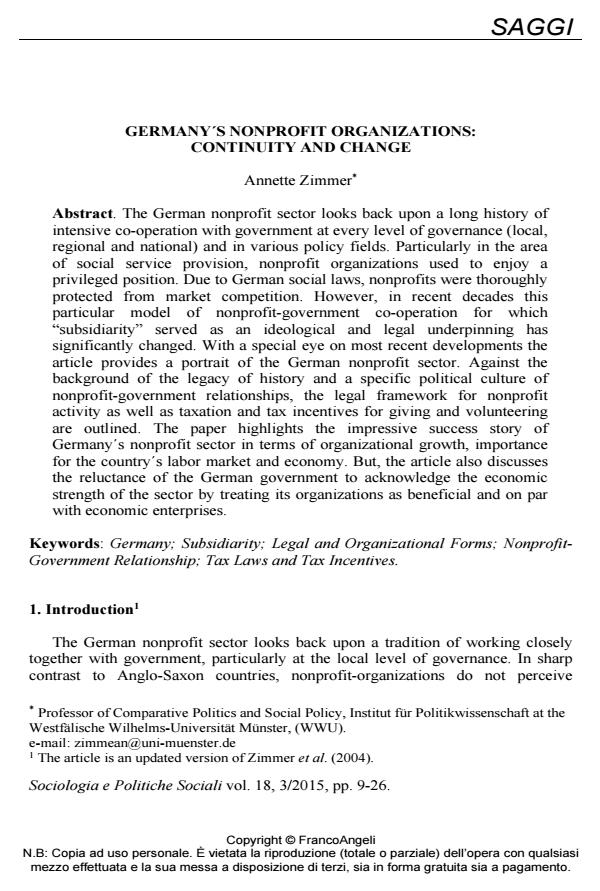Germany´s nonprofit organizations: continuity and change
Journal title SOCIOLOGIA E POLITICHE SOCIALI
Author/s Annette Zimmer
Publishing Year 2016 Issue 2015/3
Language English Pages 18 P. 9-26 File size 111 KB
DOI 10.3280/SP2015-003002
DOI is like a bar code for intellectual property: to have more infomation
click here
Below, you can see the article first page
If you want to buy this article in PDF format, you can do it, following the instructions to buy download credits

FrancoAngeli is member of Publishers International Linking Association, Inc (PILA), a not-for-profit association which run the CrossRef service enabling links to and from online scholarly content.
The German nonprofit sector looks back upon a long history of intensive co-operation with government at every level of governance (local, regional and national) and in various policy fields. Particularly in the area of social service provision, nonprofit organizations used to enjoy a privileged position. Due to German social laws, nonprofits were thoroughly protected from market competition. However, in recent decades this particular model of nonprofit-government co-operation for which "subsidiarity" served as an ideological and legal underpinning has significantly changed. With a special eye on most recent developments the article provides a portrait of the German nonprofit sector. Against the background of the legacy of history and a specific political culture of nonprofit-government relationships, the legal framework for nonprofit activity as well as taxation and tax incentives for giving and volunteering are outlined. The paper highlights the impressive success story of Germany´s nonprofit sector in terms of organizational growth, importance for the country´s labor market and economy. But, the article also discusses the reluctance of the German government to acknowledge the economic strength of the sector by treating its organizations as beneficial and on par with economic enterprises.
Keywords: Germany; Subsidiarity; Legal and Organizational Forms; Nonprofit- Government Relationship; Tax Laws and Tax Incentives
- Zivilgesellschaft und Wohlfahrtsstaat im Wandel Katharina Obuch, Christina Grabbe, pp.143 (ISBN:978-3-658-16998-5)
- Challenges to Nonprofit Organization Participation in Social and Development Policy Planning in South Africa Sokeibelemaye Nwauche, Shawn Teresa Flanigan, in Nonprofit Policy Forum /2022 pp.119
DOI: 10.1515/npf-2021-0049 - The Nonprofit Starvation Cycle: Empirical Evidence From a German Context Peter Schubert, Silke Boenigk, in Nonprofit and Voluntary Sector Quarterly /2019 pp.467
DOI: 10.1177/0899764018824669 - A Framework to Integrate Non-profits into Development Planning in South Africa Sokeibelemaye Nwauche, in VOLUNTAS: International Journal of Voluntary and Nonprofit Organizations /2023 pp.1134
DOI: 10.1007/s11266-022-00536-w
Annette Zimmer, Germany´s nonprofit organizations: continuity and change in "SOCIOLOGIA E POLITICHE SOCIALI" 3/2015, pp 9-26, DOI: 10.3280/SP2015-003002